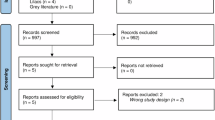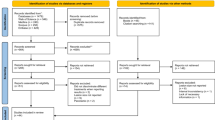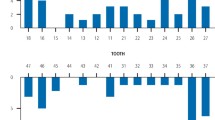Abstract
Data sources
Literature was searched using the Cochrane Controlled Trials Register (CENTRAL), Medline, Embase and HealthStar databases. Reference lists from identified articles were scanned and a further search made using names of authors of the identified articles. Papers that had cited these publications were also identified through the Science Citation Index to identify potentially relevant subsequent primary research.
Study selection
Two reviewers scanned all titles and abstracts. An article was included if subjects had a no relevant medical history; subjects presented with mature teeth with infected necrotic root canals and radiographic evidence of periapical bone loss (as an indication of preoperative canal infection), all selected root canals had not received any endodontic treatment previously, participants underwent nonsurgical root canal treatment during the study, and the number of teeth showing radiographic evidence of healing was the outcome measure.
Data extraction and synthesis
Data were abstracted by two reviewers. The principal measure of treatment effect was risk difference with the fixed-effect method for combining study estimates being used to produce an overall estimate. Between-study heterogeneity was assessed using standard χ2 test or Q-statistic.
Results
Only three randomised controlled trials (RCT) were identified and included in the review, covering a total of 146 cases. Sample size of all three studies was small. None demonstrated a statistically significant difference in healing rates. Risk differences (RD) of included studies were combined using the inverse variance-weighted method (pooled RD, −6.3%; 95% confidence interval, −20.3 to +7.8).
Conclusions
Based on the current best available evidence, single-visit root canal treatment appears to be slightly more effective than multiple visits, that is, it had a 6.3% higher healing rate. The difference in healing rate between these two treatment regimens was not statistically significant (P=0.3809), however.
Similar content being viewed by others
Log in or create a free account to read this content
Gain free access to this article, as well as selected content from this journal and more on nature.com
or
References
Farzaneh M, Abitbol S, Lawrence HP, Friedman S . Treatment outcome in endodontics — the Toronto Study. Phase II: initial treatment. J Endod 2004; 30:302–309.
Salehrabi R, Rotstein I . Endodontic treatment outcomes in a large patient population in the USA: an epidemiological study. J Endod 2004; 30:846–850.
Moshonov J, Slutzky-Goldberg I, Gottlieb A, Peretz B . The effect of the distance between post and residual gutta-percha on the clinical outcome of endodontic treatment. J Endod 2005; 31:177–179.
Fouad AF, Burleson J . The effect of diabetes mellitus on endodontic treatment outcome: data from an electronic patient record. J Am Dent Assoc 2003; 134:43–51; quiz 117–118.
Fouad AF, Zerella J, Barry J, Spangberg LS . Molecular detection of Enterococcus species in root canals of therapy-resistant endodontic infections. Oral Surg Oral Med Oral Pathol Oral Radiol Endod 2005; 99:112–118.
Author information
Authors and Affiliations
Additional information
Address for correspondence: Harold H Messer, Department of Restorative Dentistry, School of Dental Science, University of Melbourne, 711 Elizabeth Street, Melbourne, Victoria 3000, Australia. E-mail: hhm@unimelb.edu.au
Sathorn C, Parashos P, Messer HH. Effectiveness of single- versus multiple-visit endodontic treatment of teeth with apical periodontitis: a systematic review and meta-analysis. Int Endod J 2005; 38:347–355
Rights and permissions
About this article
Cite this article
Hargreaves, K. Single-visit more effective than multiple-visit root canal treatment?. Evid Based Dent 7, 13–14 (2006). https://doi.org/10.1038/sj.ebd.6400372
Published:
Issue date:
DOI: https://doi.org/10.1038/sj.ebd.6400372



